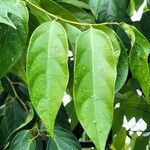A large tree, 10-40 (rarely-60) m, 20-60 (-80, or more) cm ø, all parts reeking of garlic or onion especially after rain and from cut or bruised parts; crown dense; bole usually straight, notched, sometimes with small buttresses; bark grey to dark brown, fissured and thinly rectangularly flaky, inwards dark red with coarse orange flecks; wood hard, slash generally yellow to orange-brown, rarely whitish. Branchlets smooth and glabrous at tips, older parts dark coloured with elongate lenticels. Leaves generally elliptic-, rarely lanceolate-oblong, apex rather abruptly acuminate for 1-2 cm, base cuneate to rounded, entire, subcoriaceous to coriaceous, shining green above, paler beneath when fresh, dull olive-green when dry, glabrous, often densely minutely tubercled mainly on upper surface by spicular cells or sclereids which show remarkably in dry leaves, 7-15 (-22,-32) by 3-5 (-7,-12) cm; nerves 4-5 (-7) pairs, distant, curved-ascending (one marginal rather inconspicuous), flat above, much raised beneath as are the midrib and the transverse veins, reticulations rather faint; petiole swollen distally, 1 — 1.5 (-2) cm. Racemes rusty-to greyish-puberulous; rachis 2 (-4) cm; flowers along rachis either solitary or 2 or 3 in a group; pedicels 1.5-2 mm. Calyx small with wavy edge. Petals narrow-oblong, yellowish, pink or usually creamy white, 8-10 (-15) by 2 mm, brushed-woolly inside, finally reflexed. Anthers yellow, 3-4 mm. Ovary yellowish green, tapering to the thickish white style. Drupe superior globose to rather pear-shaped, with numerous vertical stripes or faint ribs in the dry state, glabrous, green, (3-) 4-5 (-7.5) cm ø, on peduncle 1 by 0.5 cm; pericarp thin, fleshy; endocarp woody, 2-2.5 mm thick, wrinkled by an outer layer of numerous vertical fibre-like stony strands, and an inner one of compact stone cells. Seed 1, subglobular.
More
A tall tree. It grows 40 m tall. The branches start at five meters above ground. The trunk is 36 cm across. The bark is cracked and brown. There is a red colour under the bark. The bark has a distinct garlic odour. The leaves are leathery and shiny green. They are 10-22 cm long by 4-9 cm wide. They are rounded at the base and taper to the tip. The flowers are white and 1.5 cm long. They can occur singly of in groups of 2-3. The fruit are round and green. They are 5 cm across. They have a hard case and a thin fleshy pulp. The fruit are edible. Young leaves are eaten as vegetables.
In primary, or often disturbed or secondary lowland forest, on flat (sometimes seasonally flooded) country or undulating hillsides, up to 600 (rarely-900) m, on sandy or clayey, rarely blackish soil, scattered, but locally frequent.
More
Scattered but may be locally common or even gregarious in primary rain forest. On alluvial sites near rivers and streams and on hillsides. In secondary forests usually present as a pre-disturbance remnant.
A tropical plant. It grows in lowland forests and up to 600 m altitude. It needs well drained soils for good growth.

